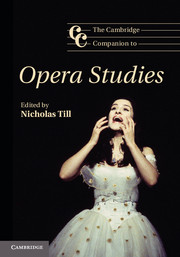Book contents
- Frontmatter
- Contents
- Contributors
- Acknowledgements
- Introduction: opera studies today
- Part One Institutions
- Part Two Constituents
- Part Three Forms
- Part Four Issues
- 11 Opera and gender studies
- 12 Opera and national identity
- 13 ‘An exotic and irrational entertainment’: opera and our others; opera as other
- Further reading
- Index
- References
11 - Opera and gender studies
from Part Four - Issues
Published online by Cambridge University Press: 05 December 2012
- Frontmatter
- Contents
- Contributors
- Acknowledgements
- Introduction: opera studies today
- Part One Institutions
- Part Two Constituents
- Part Three Forms
- Part Four Issues
- 11 Opera and gender studies
- 12 Opera and national identity
- 13 ‘An exotic and irrational entertainment’: opera and our others; opera as other
- Further reading
- Index
- References
Summary
…if woman had no existence save in the fiction written by men, one would imagine her a person of the utmost importance; very various; heroic and mean; splendid and sordid; infinitely beautiful and hideous in the extreme; as great as a man, some think even greater. But this is woman in fiction. In fact, as Professor Trevelyan points out, she was locked up, beaten and flung about the room.
A very queer, composite being thus emerges. Imaginatively she is of the highest importance; practically she is completely insignificant. She pervades poetry from cover to cover; she is all but absent from history.
Virginia Woolf, A Room of One’s Own (1929)Virginia Woolf’s contrast, between the centrality of women as represented in fiction and their virtual absence from the roster of those who have created fictional representations, may readily yet incompletely be adapted for the history of opera. It is easy enough to insert operatic heroines into Woolf’s sardonic parade of martyrs, dominatrices and self-sufficient charmers: ‘Certainly, if we consider it, Violetta must have had a way about her; Carmen, one would suppose, had a will of her own; Susanna, one might conclude, was an attractive girl.’ And, as in the history of literature, women have been all but absent from the operatic activities that received scholarly attention before the late 1980s: few traces remain of women composing, staging, theo-rizing about or paying for opera. Yet at the same time it would be absurd to describe women as ‘all but absent from [opera's] history’, when women – not only as dying heroines but as living divas – have been so central to this art’s fascination for audiences, patrons, enthusiasts and critics.
- Type
- Chapter
- Information
- The Cambridge Companion to Opera Studies , pp. 257 - 275Publisher: Cambridge University PressPrint publication year: 2012
References
- 1
- Cited by

